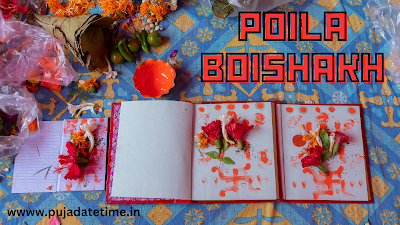History and Significance of Poila Boishakh:
The festival gained popularity in Bengal during the reign of Nawab Siraj ud-Daulah in the 18th century. He declared Poila Boishakh as a public holiday and held grand celebrations at his palace. The festival became an integral part of Bengali culture, and people started celebrating it with great enthusiasm.
Traditions and Celebrations:
One of the most important traditions of Poila Boishakh is the "Haal Khata" ceremony. In this ceremony, shopkeepers and businessmen open a new ledger book for the upcoming year and offer prayers to Lord Ganesha and Goddess Lakshmi for prosperity and good fortune. They also distribute sweets among their customers.
Another significant tradition is the "Nobo Borsho" feast. Families prepare elaborate meals consisting of traditional Bengali dishes like fish curry, rice, dal, and various vegetable dishes. Sweets such as Rosogolla, Sandesh, and Mishti Doi are also an essential part of the feast.
In West Bengal, people gather in large numbers on the streets to participate in the "Prabhat Pheri" or the morning procession. The procession features cultural programs, including music and dance performances, and ends with a community lunch.
In Bangladesh, Poila Boishakh is celebrated as a national holiday. People visit the Ramna Batamul, a park in Dhaka, to attend the "Pohela Boishakh Mela," a fair that showcases traditional handicrafts, foods, and dresses. Cultural programs, including poetry recitation, music, and dance performances, are also held at the fair.
Conclusion:
- When is Poila Boishakh celebrated? Answer: Poila Boishakh is usually celebrated on 14th or 15th April every year.
- What is the history behind Poila Boishakh? Answer: The celebration of Poila Boishakh can be traced back to the Mughal era when Emperor Akbar introduced the Bengali calendar to facilitate tax collection.
- How is Poila Boishakh celebrated? Answer: Poila Boishakh is celebrated with great enthusiasm and involves various cultural programs, music, dance, and food. People wear new clothes and visit their friends and family members to exchange greetings and sweets.
- What are some traditional dishes prepared during Poila Boishakh? Answer: Some popular dishes prepared during Poila Boishakh include panta bhat (fermented rice), ilish machh bhaja (fried Hilsa fish), cholar dal (chickpea curry), and mishti doi (sweet yogurt).
- Are there any specific rituals associated with Poila Boishakh? Answer: Yes, there are several rituals associated with Poila Boishakh. People clean their homes, decorate them with alpana (colorful designs), and perform puja to seek blessings for a prosperous new year.
What is the significance of wearing new clothes during Poila Boishakh? Answer: Wearing new clothes during Poila Boishakh symbolizes new beginnings and a fresh start for the new year.
What is the traditional Bengali attire for Poila Boishakh? Answer: The traditional Bengali attire for Poila Boishakh for men is a dhoti and kurta while women wear sarees or salwar kameez.
Are there any special events or parades held during Poila Boishakh? Answer: Yes, in Kolkata (West Bengal), a grand procession called the "Prabhat Pheri" is held early in the morning on Poila Boishakh. In Bangladesh, a colorful parade called the "Mangal Shobhajatra" is held to celebrate the day.
How long does the celebration of Poila Boishakh last? Answer: The celebration of Poila Boishakh usually lasts for three days, starting from Poila Boishakh and ending on the third day.
Is Poila Boishakh celebrated only in West Bengal and Bangladesh? Answer: No, Poila Boishakh is celebrated by Bengalis all over the world, including other Indian states like Assam, Tripura, and Odisha.
- Poila Boishakh
- Bengali New Year
- Traditions of Poila Boishakh
- Significance of Poila Boishakh
- Haal Khata ceremony
- Nobo Borsho feast
- Prabhat Pheri
- Pohela Boishakh Mela
- Bengali culture













0 Comments